After a month and a half of reporting on the unfolding war in Ukraine, I decided to visit the Pridnestrovian Moldavian Republic (PMR)—more commonly called Transnistria. I wanted to view another aspect of this story and see the perspective of some Russian-backed separatists. Denys Trach, a Ukrainian Army junior sergeant I met in Odessa right before I left for Transnistria, warned me against going to Moldova’s breakaway statelet.
“I consider the territory of Transnistria dangerous because of the presence of Russian special services,” Trach explained. “When I need, I travel from Odessa to Chisinau exclusively through the territories controlled by the governments of Ukraine and Moldova. It’s not worth trying to go.”
Transnistria is located mostly on the east bank of the Dniester river. Wedged between Ukraine and Moldova, it is internationally recognized as part of Moldova. It has all the local characteristics of statehood: a defined border, passports, military, currency in the form of the Pridnestrovian Ruble, and even license plates. But it lacks international recognition. Only three other partially-recognized states recognize it: Abkhazia and South Ossetia, which are still internationally considered part of Georgia, and Artsakh, internationally considered part of Azerbaijan. Russia uses all of these breakaway states as pawns in its foreign policy to keep former territories in Moscow’s orbit.
Relations were cordial enough that locals and tourists could travel between the two with relative ease, so I took a bus from Moldova’s capital Chișinău to Transnistria’s capital, Tiraspol, on April 9th. The Transnistrian border is manned by Russian troops, with a Pridnestrovian customs building to the rear of the Russian roadblock. I had applied for Pridnestrovian press accreditation, but hadn’t gotten it, so I entered on a tourist visa. I received a travel slip at the border.
I checked into a hostel in Tiraspol, an eerie timewarp of Soviet paraphernalia. A massive painting of Lenin hung over the communal dining table, gazing upon those who enter, together with a lifesize printout of Stalin on the door across the room. Russian flags, portraits of Putin, old newspaper clippings, and Soviet relics adorned the walls of hallways, the reception area, and even bathrooms. What was already a strange bed and breakfast was juxtaposed with modern-day American motivational posters, a fridge that looked like an English phone booth, and kitschy decorative license plates.
That aesthetic wasn’t limited to the hostel. The uniting culture of Transnistria is neo-Soviet, with more hammers, sickles, and red stars than a visitor can count. Statues of Lenin are a frequent sight found in front of government buildings. The entire statelet seemed like a Soviet Disneyland. “Lenin is to Transnistria what Lincoln is to USA,” explained a man we’ll call Sergei, a Tiraspol local introduced to me by a friend in Chișinău. “Lincoln freed the slaves and Lenin freed the Slavs from the Czar.”
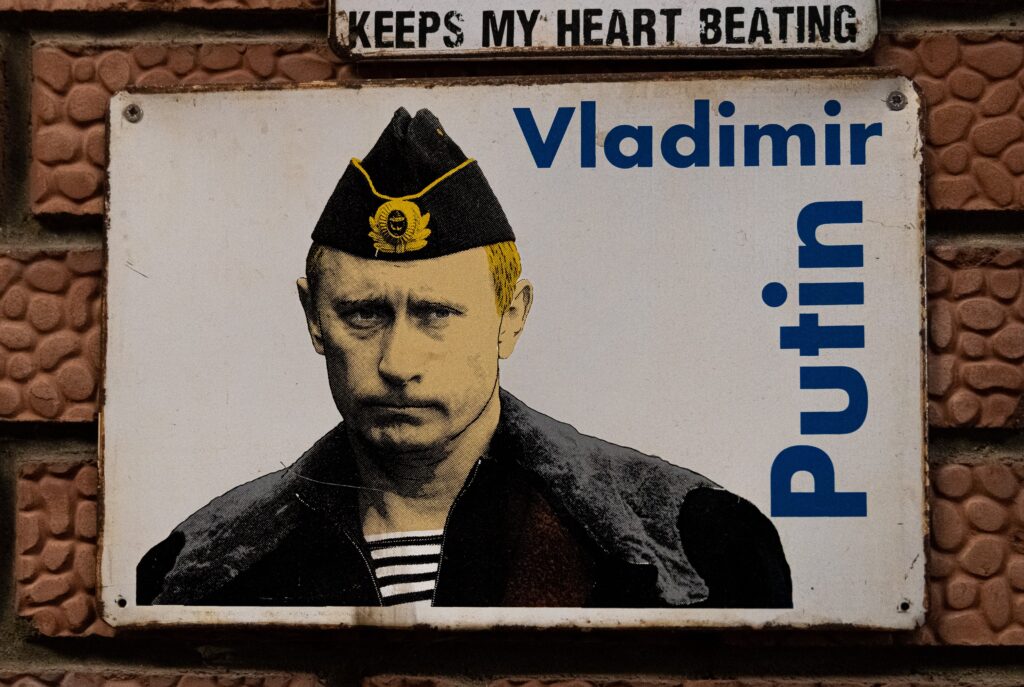
Prelude to War and De Facto Independence
The Moldovans, like many nations in the Soviet embrace, saw a rekindled nationalist spirit emerge during the last days of the USSR. Policies like glasnost created more possibilities of challenging the central state. In 1988, the nationalist Popular Front of Moldova demanded that the Soviets make Moldovan the sole, official language of the Moldovan SSR, and abandon the Cyrilic alphabet. Radicals in the party supported even more ethnocentric policies, such as deportation of Slavs and Gagauz, a Turkic people in the south of the country. The Popular Front intended Moldova to be for the Moldovans and Romanians, which they mostly considered one people.
The Moldovan Supreme Soviet acquiesced to some Popular Front demands in 1989 and adopted Moldovan as the state language with the Latin alphabet, though Russian remained a secondary language. But the Popular Front’s ethnocentric positions alienated Transnistria’s Russian population. The United Work Collective Council (OSTK), alongside other industrial leaders, took control of local soviets. Referendums on independence and the use of Cyrillic were held in the region between 1989 and 1990 and saw widespread support, though they were condemned by the Moldovan government.
Transnistria declared independence as the Pridnestrovian Moldavian Soviet Socialist Republic (PMSSR) in September of 1990. The Popular Front responded with militias to prevent a Gagauz autonomy referendum nearby. Transnistrians formed militias in kind. Moldovan police refused to intervene when mobs of Moldovan nationalists attacked ethnically Russian parliament members. After a tense standoff, limited militia clashes between Transnistrian separatists and Moldova broke out at Dubăsari two months later. Cossacks from Russia and other Slavic volunteers assisted the Transnistrians.
After the USSR’s failed 1991 coup by communist hardliners, Transnistria declared independence from the Soviet Union. The PMSSR became the PMR, but kept the communist symbolism. It was always going to be an unstable situation, and it only took until the following year for a full-scale war to break out. Formerly Soviet, now Russian troops of the 14th Guards Army remained stationed in the region and operated on orders of neutrality, though many of the personnel defected to Transnistrian units.
In July 1992, 14th Guards intervened on the Transnistrian side and ordered an artillery strike against Moldovan forces on the west bank of the Dniester, killing approximately 700 Moldovans. The Russian intervention was the deciding factor in a PMR victory and Transnistria gaining its de facto independence. The ceasefire resulted in a trilateral security agreement by Russia, Transnistria, and Moldova, which included a provision for Russian peacekeepers to remain in Transnistria. Russian troops in Moldova proper were fully withdrawn by January 1993.
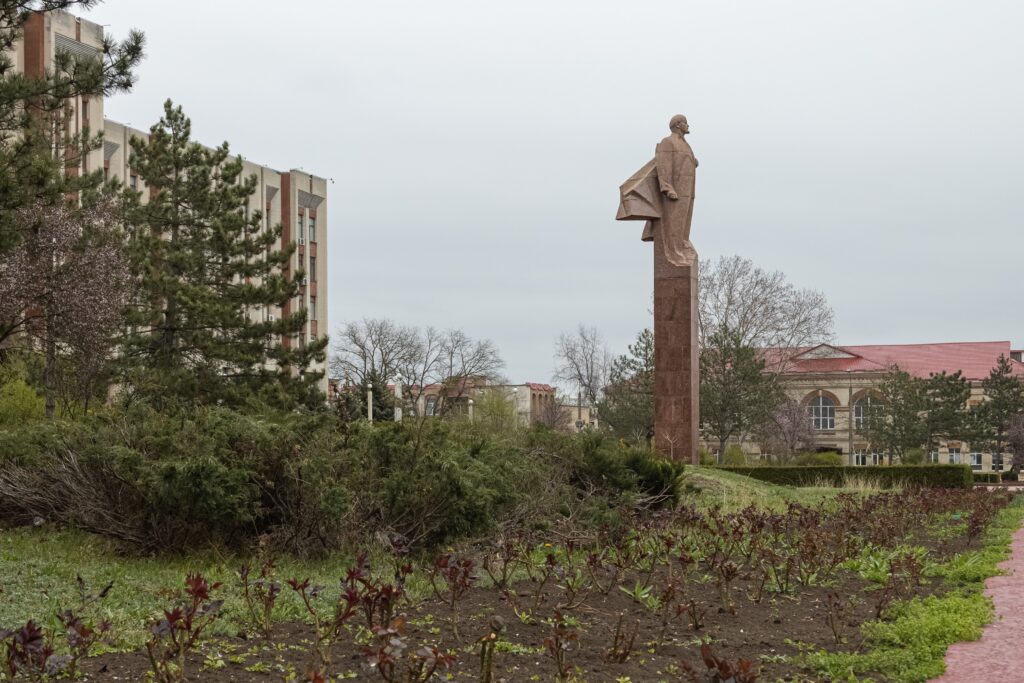
A Special Relationship with Moscow
Only Russia maintains a consulate in Tiraspol. But despite the region’s pro-Russian loyalty, Moscow prefers to keep the region at an arm’s length, and the Russian Federation does not officially recognize Transnistria as a state. In contrast, Russia officially recognizes the breakaway states of Abkhazia and South Ossetia as sovereign, and likewise recognized the Donetsk and Luhansk republics, which had existed since 2014, on February 21st, 2022—mere days before the invasion of Ukraine. After the Russian annexation of Crimea in 2014, Transnistria had officially requested to be absorbed into the Russian Federation, as an exclave similar to Kaliningrad. Moscow declined.
Part of the reason is simple geopolitics. Were Russia to recognize or annex Transnistria, Moldova would be pushed toward the West. Article 11 of the Moldovan Constitution explicitly maintains the republic as a neutral state, but Russian recognition of the PMR would likely change this. Moldova’s lack of territorial integrity allows Russia to exert influence over Moldova as a whole. The country can’t easily join the European Union or NATO because of the border dispute, though it applied for EU membership last March. However, Moldova’s closely linked neighbor, Romania, is both a NATO and an EU member.
Moldova asserts that the continued Russian presence in Transnistria, in the form of the Operational Group of Russian Forces in Transnistria (OGRF), is an illegal occupation. Russia insists on its legality under the 1992 ceasefire. Within Transnistria, it is illegal to criticize the Russian military presence or ‘spread disinformation’ on the OGRF. Per a 2016 law, public actions or statements expressing “disrespect for the peacekeeping mission of the Russian Federation…to undermine the positive role of the peacekeeping mission of the Russian Federation or to diminish the merits of the Russian Federation in maintaining peace, security, and stability in the Dniester Republic, shall be punished…by deprivation of liberty for a term of up to three years.”
Along with the borders, Russian forces maintain security checkpoints and the Cobasna ammunition depot, which holds about 22,000 tons of ammunition and military equipment. The exact number of Russian troops in Transnistria is unknown, though it likely consists of 350 to 400 soldiers. There are about 1,500 to 2,000 OGRF soldiers in total. Most remain stationed in Russia between rotations.
These Russians work in conjunction with Transnistrian forces—estimated to be between 4,500 and 7,500 troops, with 15,000 in 20,000 purported reserves. Unlike Ukraine’s breakaways in the Donbass, Transnistrian forces are cut off from the Russian mainland, making major joint operations difficult.
“What everyone calls the Russian army actually consists of Transnistrians, which have Russian citizenship,” Sergei explained. “There are not so many Russians from Russia here, maybe some officers in the army, but the soldiers are our Transnistrians who have also Russian passports.” Because a Transnistrian passport is practically useless abroad, most in the statelet have multiple citizenships—primarily Moldovan and Russian. This further obscures how many “Russian” troops are in the PMR.
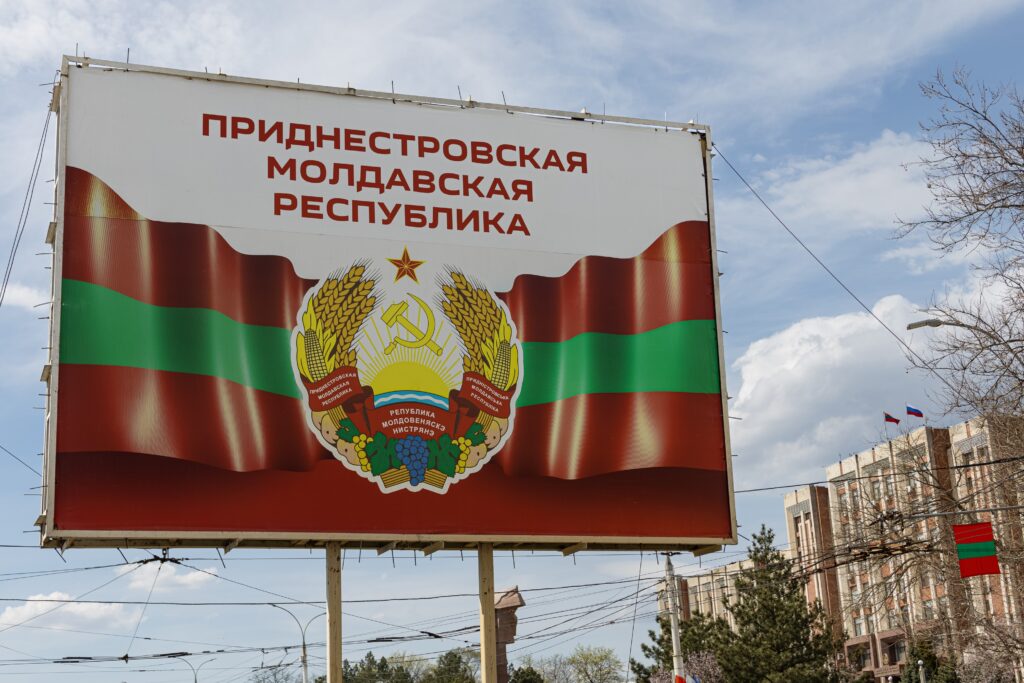
The Store That Owns a Country
Transnistria operates as a regime of “super-presidentialism,” with all major political decisions controlled by the executive. Political opponents are subject to arbitrary arrests and make allegations of torture. Opposition candidates are often delayed from registering in campaigns to limit their time on the ballot. Many parties have been banned, and unsanctioned protests can result in imprisonment.
State-owned papers, such as Pridnestrovie, dominate the Transnistrian press. Non-critical media gets subsidized while police harass unsanctioned media. A 2014 law requires citizens to report “extremist” media to the authorities, and the Organization for Security and Cooperation in Europe claims censorship is widespread.
However, the state does not block foreign television channels. Sergei hosted me in his Khrushchyovka apartment for coffee. He turned on his TV and clicked through Western news. “There are many different channels here—Ukrainian channels, Russian channels and local Transnistrian channels. I’ll turn it on for you now.” He kept going until a Western one popped up. “See? Free!” Sergei exclaimed as CNN popped up with scenes from Ukraine. “The problem is that our grandparents are older people, which means that they watch local or Russian channels. We have access to information. The problem is that most people are not taught to analyze information and explore different stories.”
But any focus on formal institutions ignores just how blurred the lines of who holds power are. There’s a common joke in Transnistria: “Every country has grocery stores but here, a grocery store has a country.” That grocery store is a company called Sheriff. Founded by two former KGB officials after independence, Sheriff has grown to entirely dominate Transnistrian markets. The conglomerate owns grocery stores, gas stations, gyms, liquor stores, a phone company, its own TV channel, a Mercedes-Benz dealership, tobacco stores, and even a football stadium home to its own team, FC Sheriff.
Transnistria is a corporate monopoly wearing a communist veneer. Sheriff loyalists, including the current president Vadim Krasnoselsky, fill positions in the government. Sheriff supports official policy in return for a reduction in import duties and taxes. The company also uses its vast resources in advertising, telecommunications, and media to sway elections—such as when Krasnoselsky defeated incumbent President Yevgeny Shevchuk in the 2016 election with the company’s backing.
“There used to be more representative offices,” Sergei explained. “Now only the party members sponsored by the Sheriff [are in office] and deputies that are also from Sheriff.” The irony is not lost on the nostalgically pro-Soviet parts of the population. My pro-Russia hostel owner expressed similar disdain. “Life was better under the USSR,” she said. “But now we are just a monopoly.”

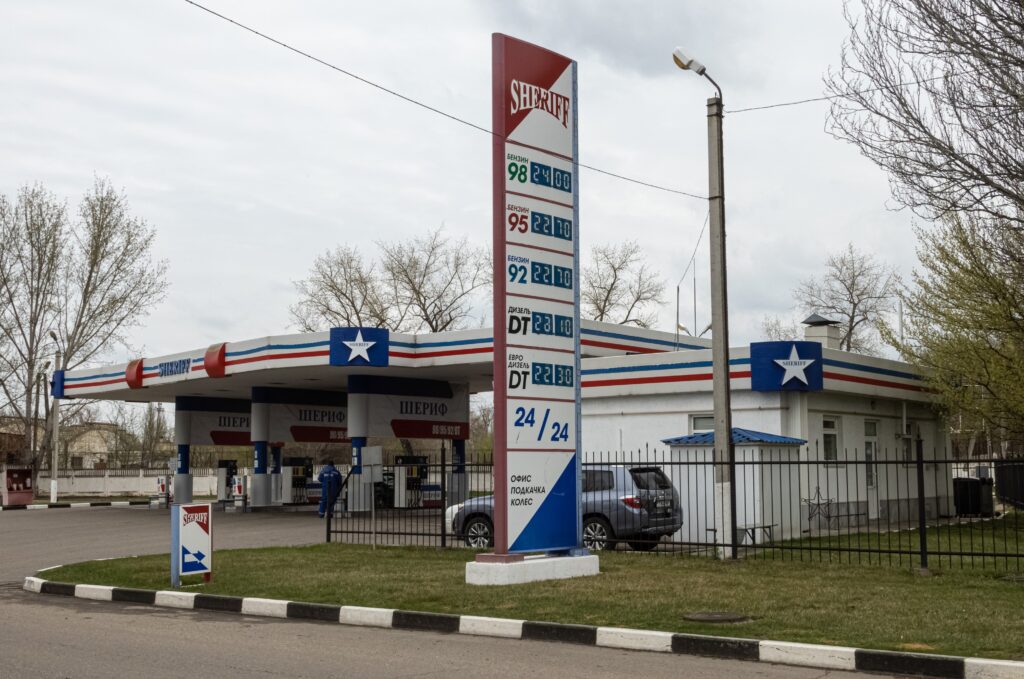
The Russian Invasion
In January 2022, a month before Russia’s invasion, Ukrainian intelligence claimed the Russian government was planning false flag operations against Russian soldiers in Transnistria to justify an attack on Odessa and other parts of Ukraine from the west. Transnistria denied this and any claims of mobilization. President Krasnoselsky stated the army “functions in a standard mode; military units are in places of permanent deployment.”
Russia’s full-scale invasion of Ukraine began February 24, when I was in Kharkiv. It immediately sparked a more aggressive European stance toward not only Russia and Ukraine, but also breakaway states like Transnistria. The Council of Europe recognized Transnistria as Russian-occupied Moldova soon after the war began. This was the first recognition of its kind, with NATO Secretary General Jens Stoltenberg condemning the presence of “Russian troops [in Transnistria] without the consent of the government in Moldova…even before the Russian invasion of Ukraine, these countries faced serious challenges partly inflicted by or caused by Russia, but the risk has increased.”
The Ukrainian Deputy Defense Minister Hanna Malyar claimed that Russian troops were massing in Transnistria on April 14th. The PMR, however, has repeatedly stated that it intends to remain neutral. Transnistria has even accepted Ukrainian refugees.
However, most Transnistrians remain staunchly pro-Russian. T-shirts and photos of Vladimir Putin are a common sight in Tiraspol. A quiet minority of Transnistrians, like Sergei, feel differently. “As a Christian, I cannot support Putin’s war,” he said. “People see war in Ukraine and say ‘the Russians in Transnistria are in danger, they must be protected.’ This becomes, as it were, a legitimate reason to bring more troops here.” He also did not believe that locals tended to consider Ukraine itself a major actor in the conflict.“ Here, most people consider the war in Ukraine as a war between America and Russia on the territory of Ukraine.” When I asked if he meant NATO or the United States specifically, Sergei said “NATO is equally America for the people here.”
The owner of my hostel shared the more mainstream Transnistrian opinion: the Russian invasion of Ukraine was justified. “Well, we are Russian, so obviously we support Russia. NATO’s expansion is major provocation, and Russia is protecting the interests of ethnic Russians,” she explained. “Once the Russians take Odessa they will come here to liberate Pridnestrovie!” Before bed, she and her husband poured shots of cognac and gave toasts. Among them was “To the Soviet Union!” Her husband, already a little drunk from several earlier glasses, made an addendum: “Fuck Joe Biden.”
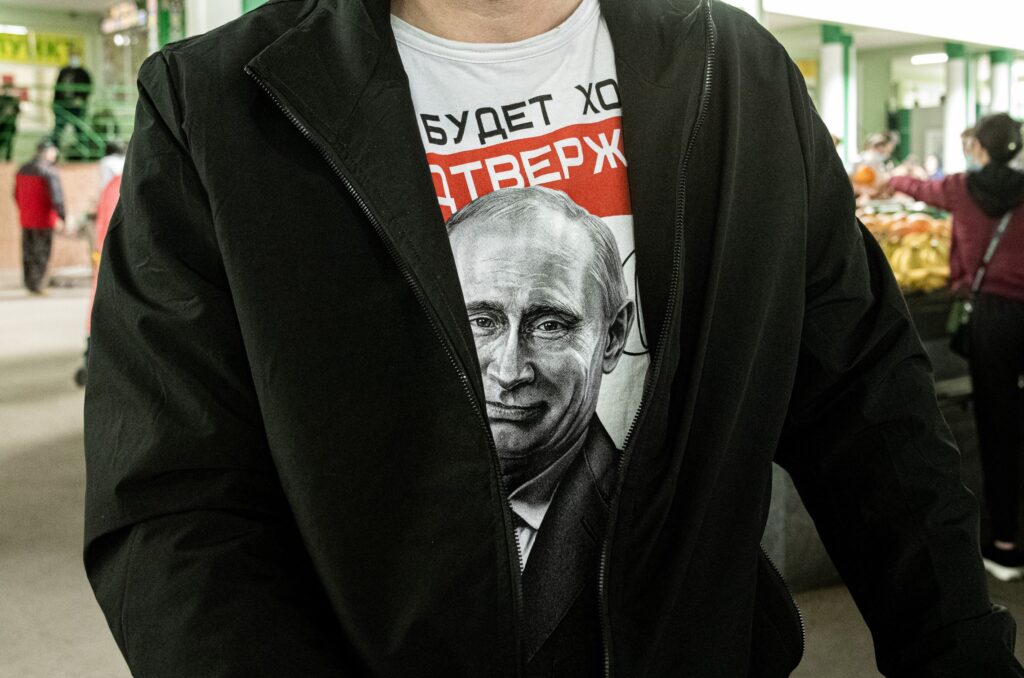
Detention, Pridnestrovian Style
Slightly hungover, I set out to photograph Sheriff properties the next morning. After photographing a Sheriff gas station and two grocery stores, a police van pulled up beside me. Two police stepped out while the driver remained inside. With broken English and Google Translate, they asked for my passport and travel slip. They were polite and took pictures of me with my papers. They even let me photograph their patches before telling me it was okay to go.
Then the police van trailed me as I walked away—the driver was on his phone. I walked about two blocks before the van sped beside me. The door flew open, and the same two cops jumped out, grabbed my arms, and forced me inside, my shin slamming the side of the van as I was shoved through the door. Passersby minded their business and watched from a safe distance.
“We go to interpreter,” said the driver. A few kilometers later, I was physically handed to other officials at a gray, concrete government building on the corner of Manoilova and Karl Marx Streets. Soldiers in Russian EMR pattern camouflage, which I knew from corpses I’d seen outside Kharkiv, manned the building inside and out. They bent my arms behind my back and marched me up the stairs at the building’s entrance, in what seemed an effort to make me feel as much discomfort and unease as possible. It worked. The seal of the Ministry of State Security hung on the wall—I was in the headquarters of the Transnistrian remnants of the KGB.
They shoved me into a holding cell, a cold room with concrete walls painted aquamarine. My left wrist was bruised from hitting the concrete door frame. There was a small window with bars that looked out onto the street, and I had a chair. An MGB agent, who eventually gave his name as Nick, came to interrogate me. He asked where I was from as he examined my passport. “Opelika, Alabama,” I said. “Oh Alabama…like the Forrest Gump,” chimed Nick. “Run Forrest, run.” He asked me where I had been in Transnistria and asked my reason for visiting Tiraspol. I told him I was there for tourism. I did enter Transnistria on a tourist visa, after all.
He pulled out his phone, and my stomach sank as he flipped through articles I wrote or contributed to on the war in Ukraine. “You are a liar,” Nick said. I was interrogated several times and had my phone and camera confiscated. I was watched closely when permitted to use a squat toilet—they could not have me try and flush a memory card. Between interrogations, I was allowed to smoke through the bars of my cell. Five Sheriff-branded cigarettes in total, I savored each one thinking it may be my last smoke for a long time.
The cell’s metal door opened and an MGB agent with a Nikon camera came to take my mugshot. I was stripped of my clothing so the agent could photograph each of my tattoos. “Typical tourist experience,” the agent with the camera gloated. “Oh wait, you’re not a tourist.” He laughed and left my cell, then came back with printouts of each tattoo to write down their significance.
The MGB copied all of the photos from my camera and phone and reiterated how I was not leaving any time soon. They were angered at seeing photos I’d taken of anti-Putin or anti-Russia posters and graffiti in Ukraine. Nick told me I had violated the 2016 law against criticizing Russian troops in Transnistria and taunted me, saying that I wasn’t going home anytime soon because of my previous news coverage.
After about seven hours in my cell, Nick reentered. “Ho ho ho, I’m Santa,” he said, throwing my camera to me. “We go now. You are getting deported.” I was expelled on charges of “coverage unfair to the Russian Federation and Pridnestrovian Moldavian Republic.” A driver took me to my hostel to grab my effects—more generosity from the MGB than I’d expected. Nick rode in the back of the car with me as we drove the half hour to the border with Moldova. I checked my map repeatedly to ensure we were actually going to the border and not some Pridnestrovian prison.
Eventually, we crossed the Dniester River at Bendery, and much to my relief, I got to the first border post. I hastily collected my things from the car’s trunk. “You may never re-enter Pridnestrovie. Go now!” Nick said. I crossed the border on foot, passing Russian troops stationed there. I was the only traveler walking, and the soldiers eyed me while their hands rested on their Kalashnikovs. “Hello,” I said awkwardly as I hurried past them, receiving a thick, Slavic “Hello,” in turn.
I walked about a kilometer to the nearest gas station knowing that was my best chance of getting a ride somewhere. After a few hours of pleading in English and Spanish to various travelers, I found space in the back of a construction truck headed to Chișinău.
I took a bus from Chișinău to Odessa soon after, eager to be back in Ukraine. After reentering, I noticed the Ukrainians had been hefting up the defenses facing Transnistria. Lines of new trenches had been dug near the territory, while tank traps and checkpoints lined the road. A crane unloaded massive concrete blocks for pill boxes and other defensive structures. The intention was clear—to defend Odessa from a northwestern attack.
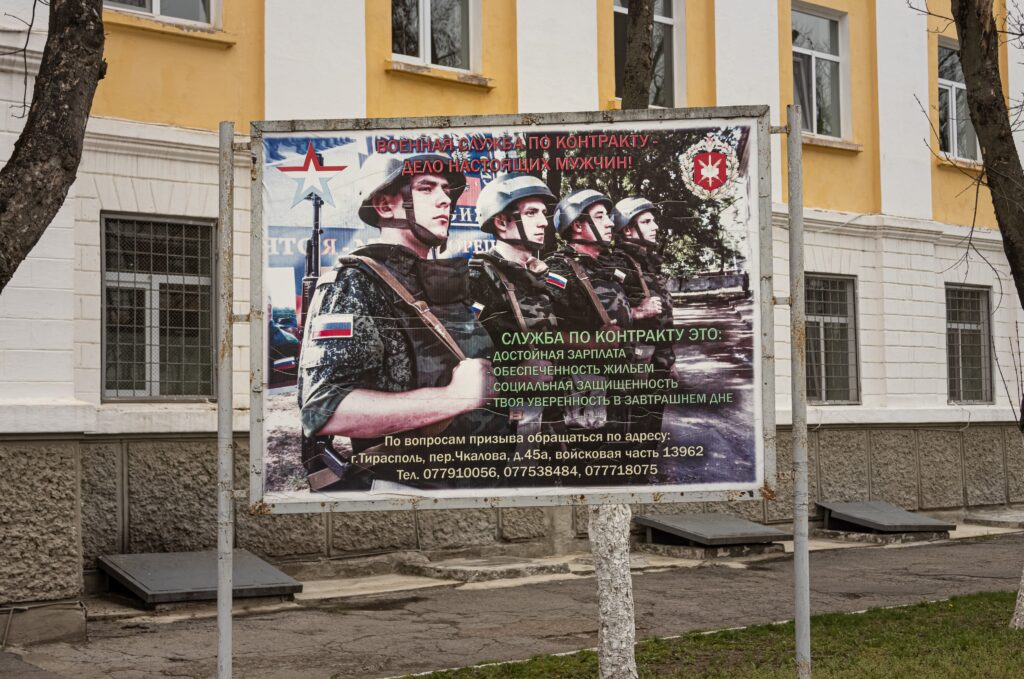
Transnistria Attacked
Two weeks after I’d been interrogated and deported, several explosions tore into the MGB headquarters in Tiraspol where I was held. Residential areas across the street had windows blown out. From a video of the aftermath, I recognized my cell as one of the rooms damaged.
The MGB building was hit by multiple RPG-22s and RShG-1s; empty launch tubes were found near the building. Security services quickly blocked the streets and forbade civilians from approaching. The attack occurred on April 25—Orthodox Easter Monday. Few employees were present, and the Ministry of Internal Affairs reported no deaths or injuries.
The Moldovan Reintegration Bureau, tasked with bringing Transnistria back into Moldova proper, claimed the attack was a Russian false flag, intended to justify future pro-Russian actions. The Ukrainian Ministry of Defence agreed. Meanwhile, Russian Major General Rustam Minnekayev, the deputy commander of Russia’s central military district, announced an objective to take control of the entire Black Sea region only a few days before the attack. He used “facts of oppression of the Russian-speaking population” as a pretext to push toward Transnistria.
The following weeks saw numerous other attacks carried out on supporting infrastructure, including a broadcasting facility for Russian state-owned networks, an ammunition depot near the Ukrainian border, and a Transnistrian “peacekeeping contingent.” In all cases, no casualties were reported. Ukraine’s military intelligence, the GUR, continued to point the finger at Russia for all attacks. Russian officials have been quieter, with Russian Deputy Foreign Minister Andrey Rudenko recently insinuating Ukrainian involvement. Within Transnistria itself, the Defense Ministry has ordered that all men between the ages of 18 and 55 mobilize to “replenish the peacekeeping contingent,” a move that could as easily signal the training of fighters.
The Cobasna ammunition depot attack was the most alarming one. It’s about two kilometers from the Ukrainian border, and is believed to be one of the largest, if not the largest, ammunition depot in Eastern Europe, containing roughly 22,000 tons of Soviet-era armaments from the 14th Guards Army, Czechoslovakia, and East Germany. If the depot exploded, the carnage would tear several kilometers into Ukraine and Moldova proper. The Moldovan government estimates that the blast could be 10 times bigger than the 2020 Beirut port explosion.
Attempts to explain the intention of the attacks are mired by the uncertain identity of the attackers. If there is a real intent to draw Transnistria into the war, more lethal options are available to all the combatants involved. But what is more likely is that the sabotage is a distraction.
As the situation stands, any attack by the PMR itself on Ukraine would be Transnistrian suicide; the statelet is just over 25 kilometers wide at its widest. Ukrainian president Volodymyr Zelensky said an attack on Ukraine would be “a slap, and we will respond to a slap with a blow.” This echoes what Sergeant Trach told me—“we would destroy them. There’s nowhere in their so-called ‘country’ that we couldn’t hit with a grad rocket.” But perhaps that’s the point—any warning signs of a Transnistrian attack serve to split Ukrainian forces, drawing them away from current positions. It’s why Zelensky has urged against being a provocateur in the region. There’s just no reason to add another front to the war.
Even if it does not end up entering the fighting, the future of Transnistria hinges on the outcome of the war. With the Russian-Western relationship now at a low point that has not been seen in decades, a peace settlement that does not settle Transnistria’s status spells a bleak future for the state. Increased pressure from an emboldened NATO and a rout of pro-Russian politicians in Moldova mean that further sanctions and isolation could be on the horizon if the Russians don’t reach the border.
That means it’s in Transnistria’s interests to play the long game, even if the Russian offensive continues to face stumbles and delays. In the aftermath of a Russian triumph on its southern front—one incorporating Odessa—Transnistria would likely become the westernmost edge of the Russian Federation, and Transnistria’s days as a forgotten Soviet time capsule would come to an end. But for now, surrounded by hostile powers, all the statelet can do is look on.
